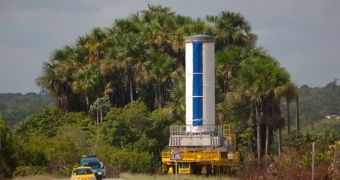The Kourou Spaceport, in French Guiana, South America, is currently bustling with activity. European Space Agency (ESA) engineers have just delivered the first stage of the first Vega rocket to its launch pad, and have already started working on it.
Vega is the smallest delivery system ESA plans to use for launching satellites to Space. Currently, the agency has access to Ariane 5 rockets developed by French company Arianespace, as well as Soyuz deliver systems it purchases from the Russian Federal Space Agency (RosCosmos).
The first Soyuz already launched from Kourou last month, carrying the first two satellites of the Galileo satellite navigation network, and now ESA is getting ready for another first at its South American installation. It plans to launch the first Vega rocket from here in late January 2012.
The launch campaign officially began on Monday, November 7, when the P80 first stage that will go on the first Vega left the ESA Booster Integration Building (BIB), and was transported to the Vega Launch Zone (VLZ). Once here, the component was placed directly on the launch pad.
The massive, 100-ton stage was ferried to the VLZ atop the Fardier heavyweight transporter, a machine similar in function to the Crawler-Transporter tracked vehicle NASA used to move its space shuttles from the Vehicle Assembly Building at the Kennedy Space Center to their respective launch pads.
During the transport, buildings near the route the Fardier vehicle took were evacuated, and as many personnel as could be spared was removed from the area. ESA has very strict safety measures in place when it comes to preventing accidents involving its rockets.
Zefiro-23 and Zefiro-9, the second and third stages of the first Vega rocket, will be added atop P80 over the coming weeks, although ESA has not yet provided a clear timeline as to when this might happen. The components are currently stored in the Vega Booster Storage and Preparation Building.
After the three stages are stacked upon each other at the launch pad, the fourth and final stage will be added as well, hopefully before the end of the year, ESA reports. This component is called the Attitude & Vernier Upper Module (AVUM).
“By the end of the year the LARES laser relativity satellite from Italy’s ASI space agency together with at least six small CubeSats and ALMASat-1 from European universities will be ready and enclosed in the fairing,” ESA adds.
“The campaign will continue in January with the integration of the ‘upper composite' – the fairing and payload – followed by final check-out of the fully integrated launcher and the countdown rehearsal,” the statement goes on to say.

 14 DAY TRIAL //
14 DAY TRIAL //